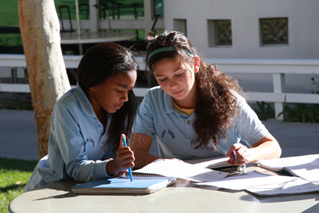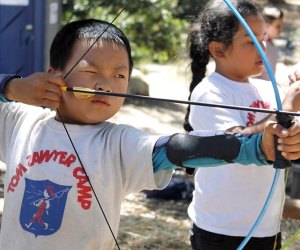Guest Blogger: Christina Simon Gives the Scoop on Applying to LA Private Elementary Schools

Christina Simon is the co-author of Beyond The Brochure: An Insider’s Guide To Private Elementary Schools In Los Angeles. She is the mom of a 3rd grade son and a 5th grade daughter who attend The Willows Community School. Christina’s work has been published on Salon.com, Mamapedia, BlogHer, The Mother Company, Scary Mommy, ecomom, and numerous other sites. She blogs at Beyond the Brochure, or you can find her on Facebook.
OUR LATEST VIDEOS
If you’re one of the thousands of parents who applied to private elementary schools in the fall, you probably just received admissions letters, and hopefully the news was good. Or, you might have friends who just got their letters. Every year in late March, LA private (independent) schools notify applicant families of their decisions. This can be a nail-biting period for families who applied, filled with the thrill of opening an acceptance letter or the disappointment of finding out their child was declined admission at their favorite school. Getting your child into a top private school in this city is time-consuming and competitive. But don’t let the rigor of the process or the hype about the popular school du jour deter you. LA has excellent private schools, which are well worth the effort to apply!
If you’re thinking about applying to private schools next year, here’s the basic information you’ll need to know. My co-authors and I like to say that the admissions process is an insider’s game, which anyone can play as long as they understand its rules. There are objective factors involved in admissions decisions, as well as subjective ones.
When my husband and I applied to kindergarten for my daughter, the schools seemed somewhat mysterious, like hidden gems. Neither of us attended private school, and most of these schools aren’t exactly an open book. Terms like “visiting day” and “parent interview” weren’t part of our daily vocabulary. That would soon change! Unlike public schools, private schools aren’t required to give you any information. They provide families with basic information about the admissions process like tour dates, their school’s programs, and application deadlines. What they don’t spell out is how to navigate the process to get your child in.
What I discovered during our school tours were a lot of impressive schools. Each one seemed more outstanding than the next. Beautiful campuses, state-of-the art technology that’s well integrated into classroom learning, small classes, innovative curriculum, talented teachers, small school size, and experienced school leadership dazzled me. Of course, private schools aren’t perfect, so doing your homework before you apply is imperative. These schools are expensive, so you absolutely must pay attention to the attributes you want in a school and your family’s educational values. If you tour a school that emphasizes its award-winning arts, drama, and choir program, but your child has no interest in the arts, this school may not be the right fit. A school that requires a two-hour drive may be fabulous, but if you can’t get your child there every day, there’s no point in applying. Do uniforms and a salute to the flag bring back bad memories of your childhood? If so, will you be happy sending your child to a school with a traditional educational philosophy? In Beyond The Brochure, we discuss the types of LA private elementary schools (traditional, developmental, progressive, and more.)
Knowing how to get started - and what to look for - can help ease your anxiety. Schools like John Thomas Dye, The Center For Early Education, Crossroads, Carlthorp, Brentwood School, The Willows School, and many other top schools receive far more applications than spots available, making it essential that you are well-informed and know what to expect.
Here’s an introduction to how it all works, to make it more manageable for your family:
Applying to kindergarten
The private elementary school application process begins in September the year before your child will enter kindergarten.
· Start by looking at school websites. You can get an idea of the school’s location, educational philosophy, and size. But don’t let the lack of a fancy website deter you. Some of the best private schools have websites that are a bit outdated. The California Association of Independent Schools website is a great place to start your search.
· Tour schools at least one year before your child will enter kindergarten (September). Most private schools require parents to tour the school before applying. However a few schools require parents to submit a written application and fee (about $100) before touring the school.
· Submit written applications to schools. Spend the time to write a unique application for each school. Cutting and pasting answers from one application to the next won’t do justice to your application.
· Parent interviews (schools interview parents about the family and the child without the child present). Be prepared for lots of questions about what you do for work, what you like to do on the weekends, your biggest parenting challenges, and whether you have any questions for the admissions director.
· Student testing or visiting day: Schools invite kids to visit the school, and they observe them in a mock classroom setting and outside on the yard. Parents wait in a separate room. Some schools also administer written tests. A few schools, like The Willows, observe the kids at the preschool rather than have parents bring the child to the school.
· Admissions letters are mailed in March. There are three types of letters: Acceptance letters (or emails), wait-list letters, and declined admissions letters. If you applied for financial aid, you may get an acceptance letter with an offer of aid, or your child may be admitted without financial aid.
Tour Early
If you’re thinking about applying for kindergarten, you may want to begin touring schools two years before you apply. This will give you an opportunity to find schools you really like and eliminate those you don’t think are right for your child. This is a big time saver. And the year you’re applying to schools you will be able to visit your favorite schools a second time to learn more about the school. You should tour at least eight schools to get a feel for the various types of schools. It’s impossible to learn about the school based on another parent’s feedback. My husband and I toured 10 schools. You really have to see each school yourself!
What Do Private Elementary Schools Really Look For?
This is definitely the most asked question my co-authors and I get from parents. The reason the top private elementary schools in this city are difficult to get into is that there are far more applicants than openings. So schools can be extremely selective in which families they accept. Most schools are looking for a good fit between the child and the school. They want kids they can teach and kids who will excel at their school, from kindergarten until graduation. They also want parents who understand and embrace their educational philosophy. Families who will be involved in the school, volunteering time and contributing financially, are also an important consideration in admissions decisions. Schools need to have an equal number of boys and girls per class. After all, you wouldn’t want your daughter in a class of 18 boys and two girls for example. And they look for ethnic and socio-economic diversity whenever possible.
A few of the intangible factors involved in admissions decisions are:
· A child may just meet the cutoff date for age requirements and could benefit from an extra year at preschool. In other words, the child is too young for kindergarten in the school’s opinion.
· Your child is a legacy (you or your spouse attended the school). This can be a big advantage.
· A family has connections or contacts at the school. Connections and letters of recommendations from parents at the school or board members don’t guarantee admission, but can help.
· Being a member of the school’s church or temple can give a family priority in admissions.
· Support from your preschool director on your child’s behalf.
Getting Wait-Listed
 What does it mean to be "wait-listed" at a private elementary school? For some schools, wait-listing a child is a polite way of saying the child is not being admitted. A few schools never send out "decline admissions" letters. Instead, they wait-list any family who was not admitted. For most schools, wait-list means that the school has offered spots to a group of families, and if any of those families decline their offer of admission, a spot will open up on the wait-list. This can happen as early as the week after letters are mailed by schools, or a wait-list spot can open in August. There is really no way to know. Some schools use ranked wait-lists or "active" wait-lists, meaning that they have a group of kids that are at the top of the wait-list. These school may or may not tell a family where they are on the wait-list, but it can't hurt to ask. Other schools keep a pooled wait-list and can select anyone from that list. But just because a friend declines a spot at a school where your child is wait-listed doesn't automatically mean that spot will go to you. It may be your friend has a girl with a January birthday. You may have a boy with a late summer birthday. The school may consider those factors when selecting from the wait-list. If your child is wait-listed, consider it a continuation of the process. Let the admissions director know you were disappointed at not being admitted, but that if a spot opens up on the wait-list, you will enroll your child. Ask your preschool director to call the admissions director on your behalf. Ask friends who have kids at the school to email or call the admissions director. This is important. The schools want to know who will accept their offers of admission. If they don't hear from you, they assume you're not interested. At virtually every school there are families who were admitted from the wait-list. While you are wait-listed, don't give up your other options! If you need to put a deposit on a school that isn't your first choice, you should. The timing can be terrible for those of you who find yourselves stuck in the wait-list situation, but you want to make sure your child has a school to attend. You will lose that deposit if you don't enroll there, but that's part of how this process works.
What does it mean to be "wait-listed" at a private elementary school? For some schools, wait-listing a child is a polite way of saying the child is not being admitted. A few schools never send out "decline admissions" letters. Instead, they wait-list any family who was not admitted. For most schools, wait-list means that the school has offered spots to a group of families, and if any of those families decline their offer of admission, a spot will open up on the wait-list. This can happen as early as the week after letters are mailed by schools, or a wait-list spot can open in August. There is really no way to know. Some schools use ranked wait-lists or "active" wait-lists, meaning that they have a group of kids that are at the top of the wait-list. These school may or may not tell a family where they are on the wait-list, but it can't hurt to ask. Other schools keep a pooled wait-list and can select anyone from that list. But just because a friend declines a spot at a school where your child is wait-listed doesn't automatically mean that spot will go to you. It may be your friend has a girl with a January birthday. You may have a boy with a late summer birthday. The school may consider those factors when selecting from the wait-list. If your child is wait-listed, consider it a continuation of the process. Let the admissions director know you were disappointed at not being admitted, but that if a spot opens up on the wait-list, you will enroll your child. Ask your preschool director to call the admissions director on your behalf. Ask friends who have kids at the school to email or call the admissions director. This is important. The schools want to know who will accept their offers of admission. If they don't hear from you, they assume you're not interested. At virtually every school there are families who were admitted from the wait-list. While you are wait-listed, don't give up your other options! If you need to put a deposit on a school that isn't your first choice, you should. The timing can be terrible for those of you who find yourselves stuck in the wait-list situation, but you want to make sure your child has a school to attend. You will lose that deposit if you don't enroll there, but that's part of how this process works.
The Cost Of Private Elementary School
Private elementary schools require you to open your wallet! The top schools range from $17-$24,000 per year. However, there are schools that cost less per year and a few that cost more annually. You should also know that tuition generally rises between 4-8 percent per year. Private schools also expect every family to participate in their annual giving campaign. The amount is up to each family and typically ranges from a few hundred dollars per year to tens of thousands. Tuition alone does not cover the cost of running these schools, so auctions, fairs, and other events are held to cover the gap between the tuition paid by each family and the school’s budget needs. Additional expenses to consider include enrichment classes, hot lunch, field trips, and sports programs.
Financial Aid
Financial assistance is available for families who qualify. At some schools, this can mean a family who earns up to $150,000 per year. The financial aid application is a separate application process from the school’s admissions process. Typically, schools award financial aid to cover part, but not all of the tuition. And most schools assume families will need financial aid for the entire time their child is at the school. However, you will be required to apply for aid every year. At most schools, admissions decisions are separate from financial aid decisions. This is called a "need blind" process. But at a few schools, a family’s financial needs may be considered as part of the admissions decisions. Over the past few years, due to the recession, some schools have been forced to move away from "need blind" and consider an applicant's ability to pay. Schools do not want to admit families who have no means to pay tuition, although this does happen. Last year was a very difficult year for new families requesting financial aid, due to the fragile economy. This year, the situation has been very similar, as existing families who have requested aid for the first time are granted the assistance so they can remain at the school. Some schools are raising additional funds to offer financial aid to new families. This is a behind the scenes process at each school, where a financial aid committee determines how to distribute the school's financial aid. Parents have no way of knowing what will happen until they get their letters.
Go Ahead, Apply!
If you’re thinking about applying to private schools, go for it! Yes, it’s competitive, but your child has just as good a chance as the next child of being accepted. So try to ignore the frenzy and focus on getting through the process. In the end, once your child is accepted at a great school, all the ups and downs of the admissions frenzy will be forgotten.
Beyond The Brochure: An Insider's Guide To Private Elementary Schools In Los Angeles is available for $30 on Amazon or at Chevalier's and Children's Book World.


























